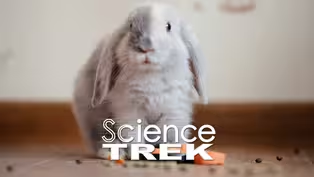
Rabbits: Rabbit Survival Guide
Clip: Special | 1m 4sVideo has Closed Captions
How do rabbits survive in the arctic and the desert?
Wild rabbits can survive in some pretty extreme environments because they have special adaptations. What do arctic hares need to thrive in the cold winter and how to antelope jackrabbits keep cool?
Problems playing video? | Closed Captioning Feedback
Problems playing video? | Closed Captioning Feedback
Science Trek is a local public television program presented by IdahoPTV
Major Funding by the Laura Moore Cunningham Foundation and the Idaho National Laboratory. Additional Funding by the Friends of Idaho Public Television and the Corporation for Public Broadcasting.

Rabbits: Rabbit Survival Guide
Clip: Special | 1m 4sVideo has Closed Captions
Wild rabbits can survive in some pretty extreme environments because they have special adaptations. What do arctic hares need to thrive in the cold winter and how to antelope jackrabbits keep cool?
Problems playing video? | Closed Captioning Feedback
How to Watch Science Trek
Science Trek is available to stream on pbs.org and the free PBS App, available on iPhone, Apple TV, Android TV, Android smartphones, Amazon Fire TV, Amazon Fire Tablet, Roku, Samsung Smart TV, and Vizio.

Science Trek
Science Trek is a place where parents, kids, and educators can watch short, educational videos on a variety of science topics. Every Monday Science Trek releases a new video that introduces children to math, science, technology, engineering, and math (STEM) career potentials in a fun, informative way.[MUSIC] JOAN CARTAN-HANSEN, HOST: Wild rabbits and hares live all over the world, even in some extreme environments.
They can do that because of special characteristics or adaptations.
For example, some arctic hares' fur turns white in the winter and brown in the summer to better blend in and hide from predators.
They have long flat feet to help stay on top of the snow and long claws to help dig for buried food.
And they have black lashes that work like sunglasses to help shade their eyes from the snow's glare.
Some rabbits have adapted to living in extreme heat.
Antelope Jackrabbits have long ears.
Not only do those long ears allow them to hear better, but they also use their ears to help dispel heat.
A number of wild rabbits and hares are threatened or endangered.
The Colombian Pygmy rabbit is almost extinct because of disease, wildfires, and habitat loss.
Even some species of the common cottontail rabbit are in trouble because of loss of its habitat.
Since rabbits and hares are an essential part of the food web, we need to protect them all.
For more information about rabbits, check out the Science Trek website.
You'll find it at ScienceTrek.org.
Rabbits: Eating Poop and the Bunny Butt
Video has Closed Captions
Clip: Special | 1m 4s | Why do rabbits eat one of their poops? (1m 4s)
Providing Support for PBS.org
Learn Moreabout PBS online sponsorship
- Science and Nature

Explore scientific discoveries on television's most acclaimed science documentary series.

- Science and Nature

Follow lions, leopards and cheetahs day and night In Botswana’s wild Okavango Delta.












Support for PBS provided by:
Science Trek is a local public television program presented by IdahoPTV
Major Funding by the Laura Moore Cunningham Foundation and the Idaho National Laboratory. Additional Funding by the Friends of Idaho Public Television and the Corporation for Public Broadcasting.
